The Arrival of the Tractor: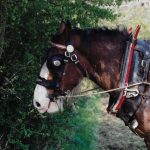
The 1940s and ‘50s were a time of dramatic and far-reaching changes in farming in Northern Ireland in common with the rest of the western world. Traditional agricultural practices, some of which dated back to the dawn of time, were superseded by the arrival of the tractor, and the move away from the horse as the main source of power on the farm. Mechanisation had arrived, and it went on to have an enormous and permanent effect on our landscape, our economy, our food and our way of life. Rural communities were particularly affected, but the ramifications and effects still run through the whole of society.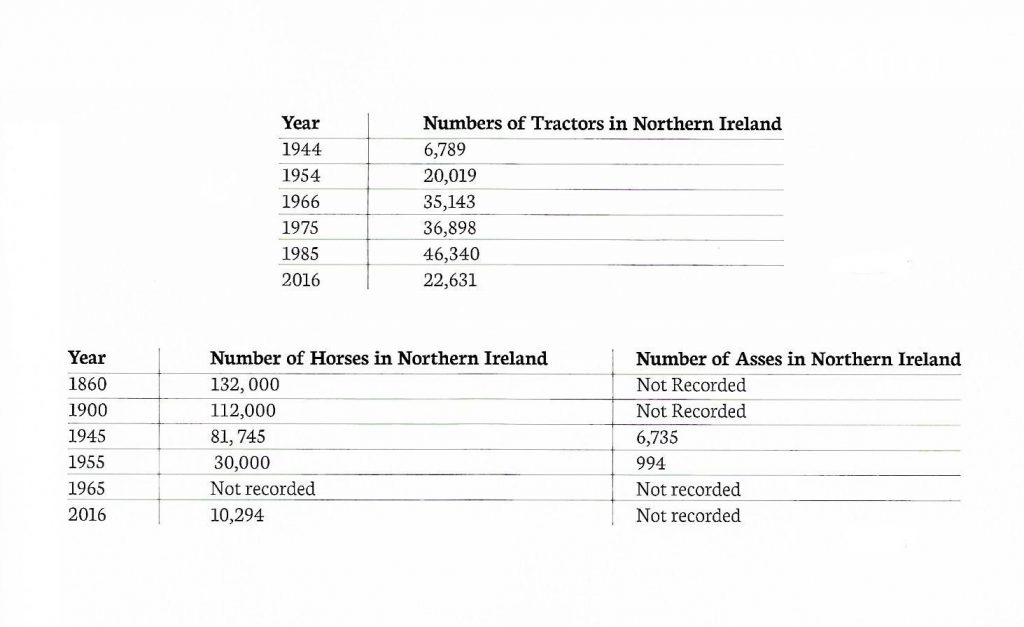
It has been said, that ‘Farming in 1940 was not significantly different in structure and practice from farming in 1840.’1 Since then the rate of change has accelerated on many fronts, technological advances, advances in science, alterations in the pattern of labour and increased government support and intervention. The technical changes between 1935 and 1965 have been characterised as being of two types:
‘the output-increasing and the labour-saving. Among the former were varietal change, fertilizers, feeding-stuffs, Friesian cows and artificial insemination (AI). Among the latter were combine harvesters, tractors and milking machines.’2
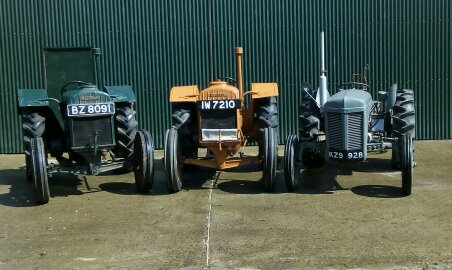
An in-depth examination of these advances and their subsequent implementation on the land is outside the scope of this project – however, the tractor arriving at a farm was really the moment when the farmer rose to meet the opportunities and challenges of the new order and stepped away from centuries of tradition and familiarity.
Each of the farms taking part in this project spanned the gap between the earlier model of farming and the new methods and techniques of tending the land. For all those involved, the arrival of the first tractor and the move away from the horse was a significant and memorable moment:
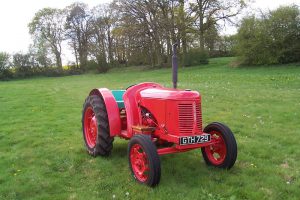
The only thing I remember doing with the horses was when they were cutting the oats. They cut across the field and they had to take the horses ‘roud to the start again. Well, that was my job. They cut one way and it was always my father doing the ‘leaving off’, then he got off at the end and I brought the horses back around…..I was about twelve. ………I collect items belonging to the horses. My brother often says to me that if you had worked with the horses you wouldn’t be so anxious now to collect those things.
……We got our first tractor in 1949, a David Brown Cropmaster costing £458. It had a double gearbox and went very fast on the road. It also had a bench seat for the driver and passenger…. The first time I remember driving the tractor was when my brothers were putting the beets of flax out to dry. (Harry Armstrong))
I remember two horses (Tommy and Johnny). It was sad to see them go when our first tractor arrived on 11th February 1954. This was a Ferguson T20 Diesel (nearly the first in the area) and she was supplied by Chesney’s of Portglenone hence the County Antrim registration; KZ9928. The price then was £550.00 approx. £16,000 – £18,000 in today’s money. …… I am proud to say I am still the owner of that tractor and that she is still going well.……………..my father used to morrow (share work) with neighbours called Doherty from the Crew. As long as I can remember, they had a Fordson. She was made during the war years because of the narrow wings – to save metal. I would think she was a 1941/42, but I still remember the registration no. IW 7961. I got driving her before our Ferguson arrived and she seemed so big then. (Raymond McNamee)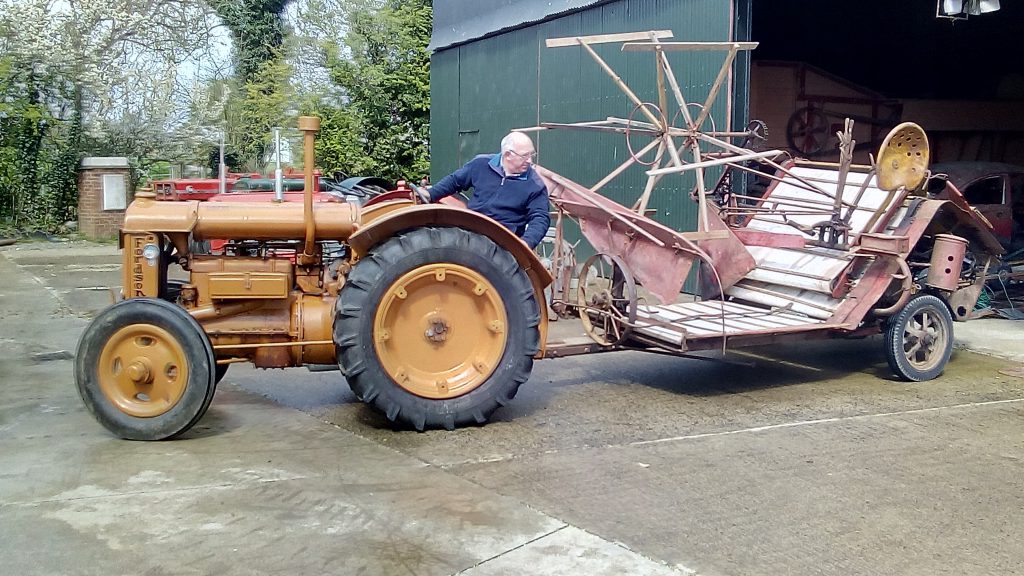
I just remember the horses and the transition to the tractor.….I do have very vivid memories of the horses working. I….remember one evening when my father had finished in the fields with the horse and was probably very tired, coming into the yard and throwing me up onto the horse’s back or neck just behind the collar and hames. The horse continued to walk towards the stable and I felt as though I had been given something special……. When you entered the stable at night it was lovely to hear the horses chewing away at the hay, the warmth in their small home was incredible, my father always checked them last thing at night before he went to bed.
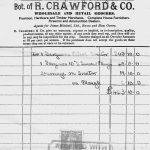 My father bought his first tractor a Ferguson TE20 TVO, registration no. NZ 2152, on the 11th May 1951 from R. Crawford & Co. Maghera. The invoice price then for the tractor was £363-10s-0d with carriage of £17-10s-0d. Together with the tractor, he bought a Ferguson two furrow plough. This was known as the ‘Ferguson System’ meaning that implements being used were carried on a three-point linkage system on the tractor and could be lifted and lowered when required. (James Armour)
My father bought his first tractor a Ferguson TE20 TVO, registration no. NZ 2152, on the 11th May 1951 from R. Crawford & Co. Maghera. The invoice price then for the tractor was £363-10s-0d with carriage of £17-10s-0d. Together with the tractor, he bought a Ferguson two furrow plough. This was known as the ‘Ferguson System’ meaning that implements being used were carried on a three-point linkage system on the tractor and could be lifted and lowered when required. (James Armour)
The first tractor bought on Shiels’ farm was in 1953/54. The introduction of the tractor was seen as a major change by Roy Shiels and Elizabeth remembers heated discussions on the topic in the Young Farmers’ Club:
…….one night in particular we were having a debate (in the Young Farmers’ Club) on ‘Horse versus Tractor’. Roy
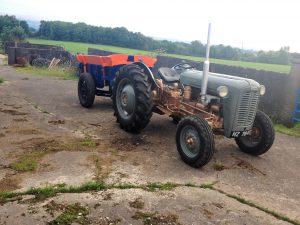
was for the horse with James Dripps from Culnady being for the tractor. The debate became an argument and the two men stood arguing all night and the Rev Anderson, being the Vice-President, intervened and said, ‘I propose that the chairman bring the debate to a close.’ Which we did.
On the farms, the tractors were a source of excitement and a challenge to the younger generation who learned to drive them straight away: Raymond McNamee was eight years old when his father bought his first tractor:
I was introduced to driving our tractor about the age of eight…. this would have been when the dung was being carted out from the farmyard to the field. About March or early spring the dung had to be hand ‘graiped’ into the cart…..and they used what was termed a ‘dreg’, which was a long-shafted graip with the toes bent at 900, to pull the dung out of the cart. When this was pulled off and enough was in the coup all I’d hear was the word ‘Right’, so I’d move forward another few yards and then it wasn’t ‘Stop’, it was ‘Whoa’, as if I were a horse. I couldn’t actually sit in the seat to get the clutch pushed down. I had to get up and stand on it.
James Armour remembers his first experience driving the tractor as well:
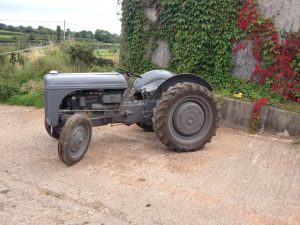
I remember the first time my father said, ‘Away you go,’ when I asked, as I had asked so often before, ‘Can I bring the tractor over?’ I was desperate to get it right…..I can still feel the mix of emotions going on in that moment…….I must have passed the test because I never looked back and by the age of ten I was a veteran driver.
With the coming of the tractor, existing machinery, suited for use with the horse, had to be either adapted or replaced. Farmers usually carried out their own alterations. Raymond McNamee describes the new equipment his father bought and the modifications he made to other pieces of machinery:
Well my father, when he bought the tractor….he bought a Fisher Humphries two furrow plough along with her because there was a screw system with her…..they were good enough ploughs but if you touched anything they were very, very easily bent…..very soft compared to the Ferguson….. He (my father) purchased a Ferguson drill plough, a Ferguson grubber and a Ferguson potato dropper which he used for planting our own potatoes…when our would have been planted he planted potatoes to the country…. He took great pride in straight drills, they had to be straight. Nowadays they put the drills in the shape of the hedge.
My father did the changes to the horse machinery…. The old horse-reaper – she’d have been an old Bamford Royal – the shaft for the horses would have been taken out of her and it replaced with a short shaft with an attachment on it that could hook on to the tractor. The hay-turner the same – an old Bamford hay-machine- the shaft on her was adapted as well and on the horse hay-rake. The horse’s cart was kept, the shafts cut off it, the large wheels with the steel rims taken off and an axle put in which allowed rubber wheels to be put on. I think most farmers round this area would have had something like that. (Raymond Armour)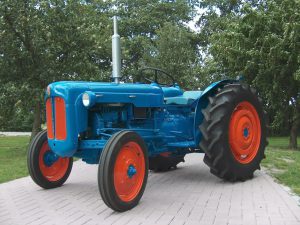
The machinery we had at that time was a tractor, mower, potato digger, plough, drill plough, cultivator and disc. With the tractor coming we altered the mower and potato digger. The plough, drill plough and cultivator were bought to work with the tractor. (Harry Armstrong)
In the ‘50s and ‘60s all you needed was a mowing machine, a plough, drill plough and grubber and maybe a set of harrows. We also had a potato digger and reaper. Some of the machines were converted from when they were used by the horse…….the potato digger, the reaper and the horse cart, we put a shaft in them or a tow-bar as we called it. (Charlie Convery)
My father kept a horse for a period of time after the tractor arrived just in case it was needed to pull a machine before conversion to suit the tractor. The machinery had to be changed, two shafts in some cases were replaced by one to enable it to be hitched up to the drawbar of the tractor. (James Armour)
The changes brought about by the tractor were immediately apparent with an immediate increase in the amount of work achieved, the reduction in effort and a corresponding increase in yield. James describes the difference he saw on his father’s farm:
In 1950 my father would have ploughed with a one- furrow horse plough an acre of land in a day with the horses and walked behind them for approximately thirteen miles, that would have been a good day’s work. In 1951 when he got the tractor and two-furrow plough he would have ploughed about five or six acres of ground in one day and walked no distance, so the increase in the amount of work that was done in a day was enormous……..in 1953, due to the increase in output he had to build a three-tier hayshed. Each tier fifteen feet long.
Despite the obvious advantages to working with the tractor, the change for farmers who had worked all their lives with horses, was not always easy. Harry Armstrong recalls the strong bond his father had with the horse:
My father would have worked almost completely with the horses. The tractor was just coming in and taking over when I started to farm. My father never drove a tractor at any time…..the children were able to drive the tractor….he never drove a car either. Machinery was taking over when I started to farm. My older brother did work a bit with the horses but my younger brother and myself…….the tractor was here by the time we started farming……As long as I remember we just had the two horses and he (my father) was sort of attached to them. They were part of the family and he kept one on for a long time though he wasn’t doing very much with it…. it was more as a pet.
James Armour also remembers the connection between the farmer and his horse:
It must have been a serious culture shock for my father -the farmers of his generation were the only ones to make such a change to their lives….. He had to say goodbye to an animal that he communicated with every day and at all times …..the horse was man’s companion, and to go from that to a mechanical machine where no form of communication was there other than by physical action, must have been like removing a part of the farmer’s anatomy. The transition from the horse to the tractor was not forced upon my father but he, and other farmers of his generation, accepted that progression. They knew it had to be embraced and they did so with a silent dignity.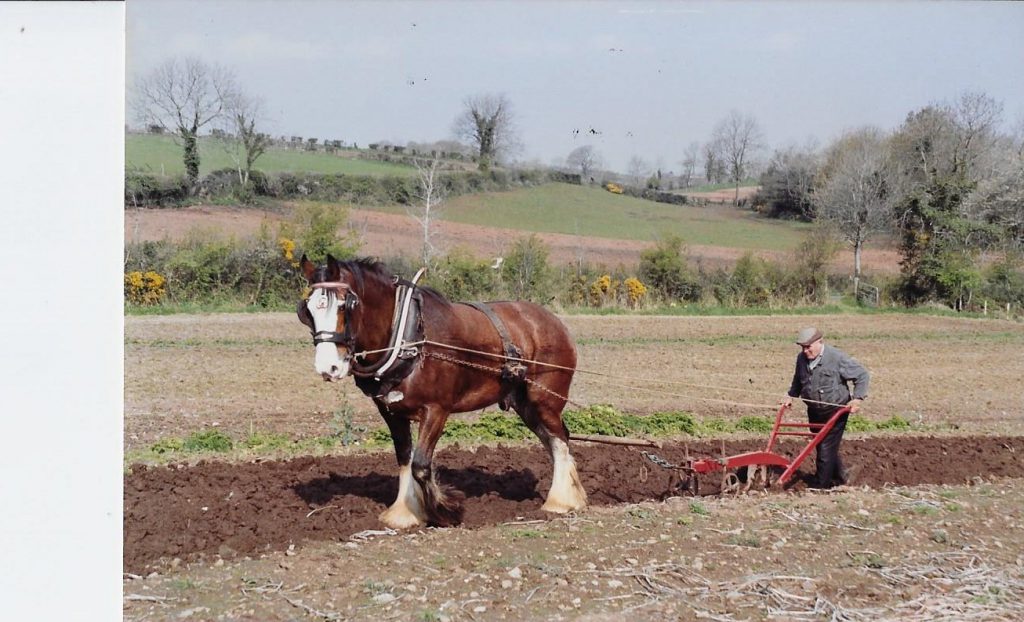
1B.A. Holderness, ‘Apropos the third Agricultural Revolution; how productive was British agriculture in the long boom, 1954-1973’, in P. Mathias and J.A. Davis eds, Agriculture and Industrialization: from the eighteenth century to the present day (1969) p.69)
2Paul Brassley ‘Output and technical change in twentieth-century British Agriculture’, Agricultural History Review 48, 1, p.71
3James A. Walsh ‘Adoption and Diffusion Processes in the Mechanisation of Irish Agriculture’, Irish Geography (1992), 25(1), p. 34
4Department of Agriculture, Environment and Rural Affairs website.
https://www.daera-ni.gov.uk/publications/historical-livestock-data-1847-date
